MKT01760 Tourism Planning: A Plan to Mitigate Coral Bleaching
VerifiedAdded on 2023/06/04
|18
|5089
|108
Report
AI Summary
This report examines the impact of climate change, specifically coral bleaching, on the Great Barrier Reef (GBR) and proposes a tourism plan for mitigation. It highlights the GBR's significance to Australia's environment and economy, emphasizing the need for responsible tourism. The plan includes strategies like the Environmental Management Charge (EMC) and focuses on reducing carbon emissions, controlling pollution, and managing dredging impacts to ensure the GBR's long-term sustainability. The report also addresses the challenges and negotiations surrounding coral reef preservation versus economic benefits, advocating for strategies that balance environmental protection with tourism industry needs.
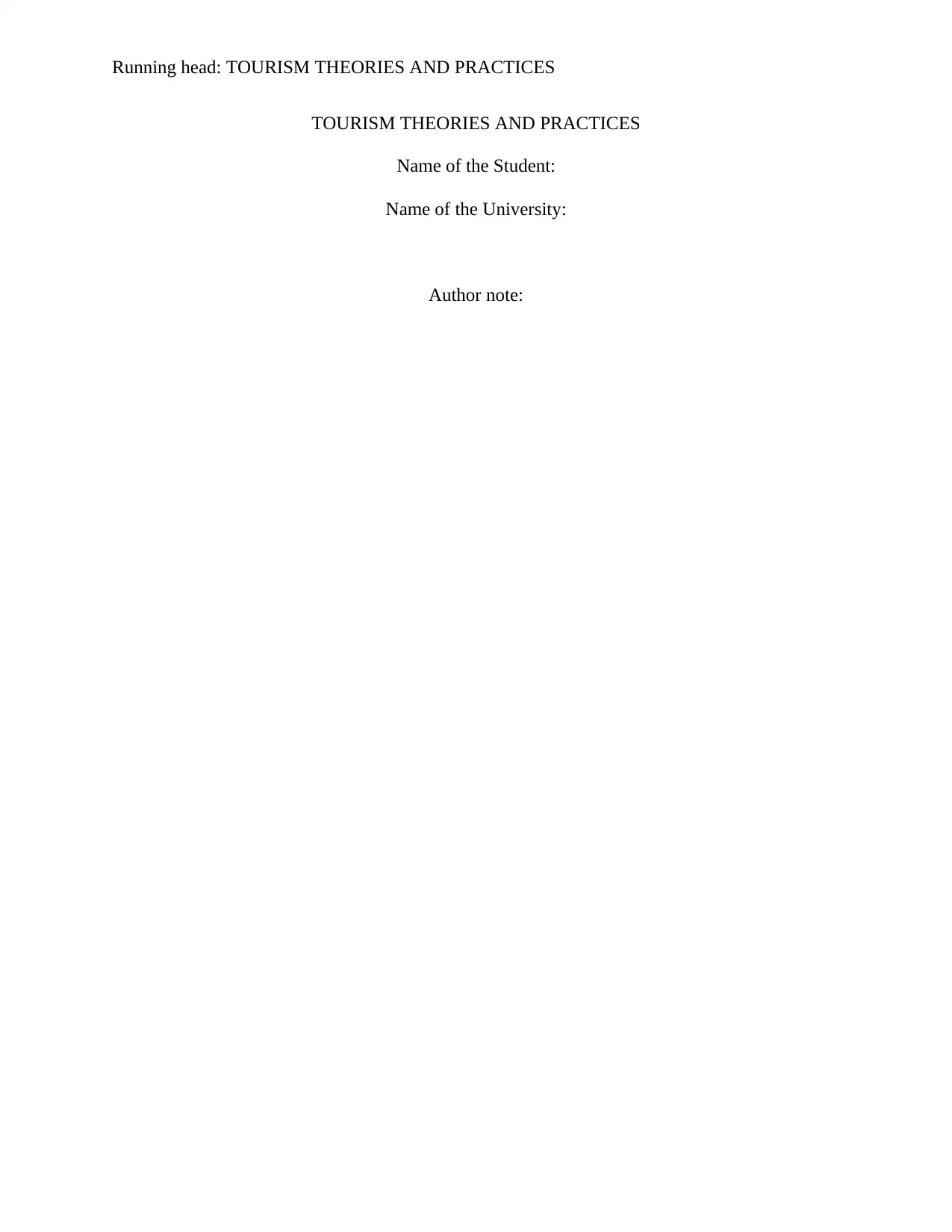
Running head: TOURISM THEORIES AND PRACTICES
TOURISM THEORIES AND PRACTICES
Name of the Student:
Name of the University:
Author note:
TOURISM THEORIES AND PRACTICES
Name of the Student:
Name of the University:
Author note:
Paraphrase This Document
Need a fresh take? Get an instant paraphrase of this document with our AI Paraphraser
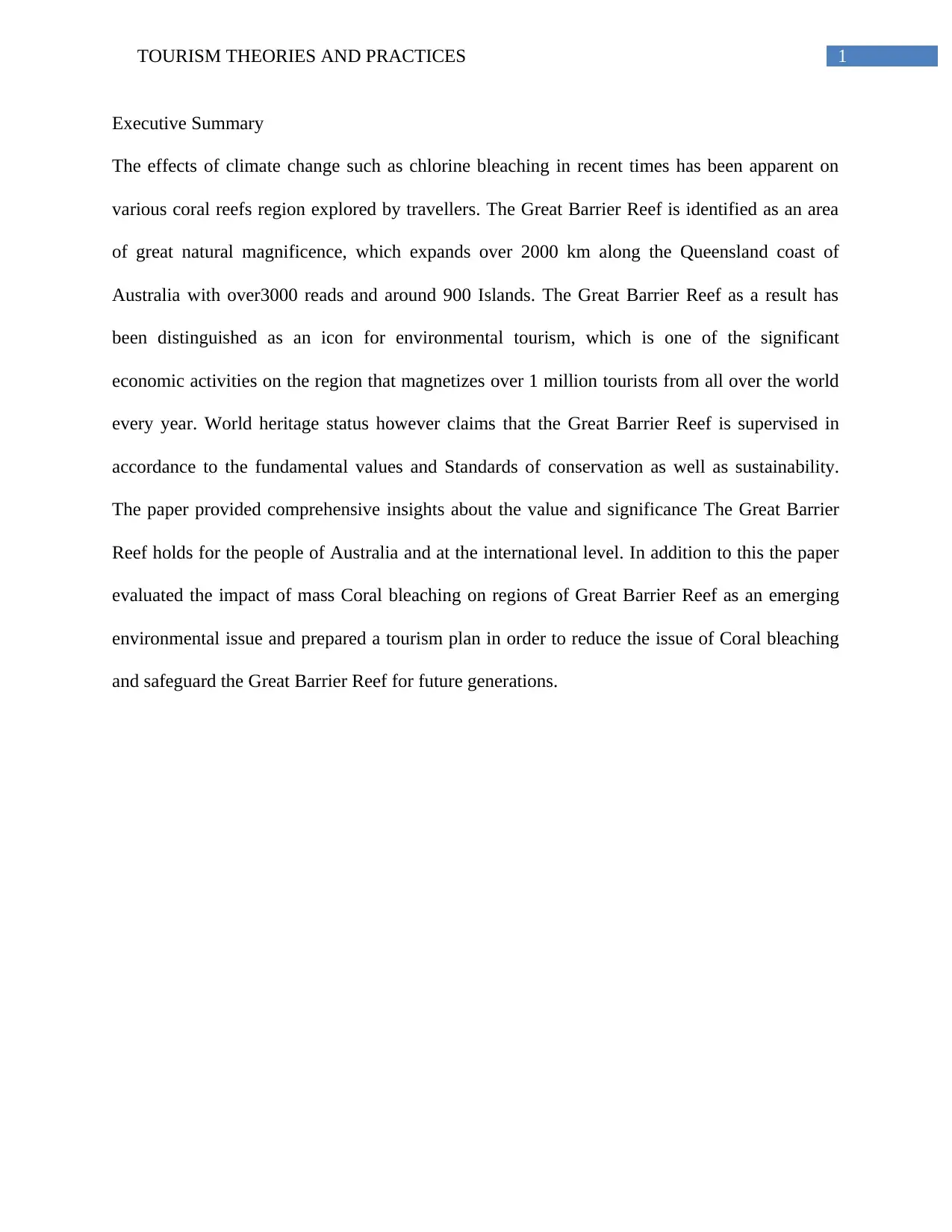
1TOURISM THEORIES AND PRACTICES
Executive Summary
The effects of climate change such as chlorine bleaching in recent times has been apparent on
various coral reefs region explored by travellers. The Great Barrier Reef is identified as an area
of great natural magnificence, which expands over 2000 km along the Queensland coast of
Australia with over3000 reads and around 900 Islands. The Great Barrier Reef as a result has
been distinguished as an icon for environmental tourism, which is one of the significant
economic activities on the region that magnetizes over 1 million tourists from all over the world
every year. World heritage status however claims that the Great Barrier Reef is supervised in
accordance to the fundamental values and Standards of conservation as well as sustainability.
The paper provided comprehensive insights about the value and significance The Great Barrier
Reef holds for the people of Australia and at the international level. In addition to this the paper
evaluated the impact of mass Coral bleaching on regions of Great Barrier Reef as an emerging
environmental issue and prepared a tourism plan in order to reduce the issue of Coral bleaching
and safeguard the Great Barrier Reef for future generations.
Executive Summary
The effects of climate change such as chlorine bleaching in recent times has been apparent on
various coral reefs region explored by travellers. The Great Barrier Reef is identified as an area
of great natural magnificence, which expands over 2000 km along the Queensland coast of
Australia with over3000 reads and around 900 Islands. The Great Barrier Reef as a result has
been distinguished as an icon for environmental tourism, which is one of the significant
economic activities on the region that magnetizes over 1 million tourists from all over the world
every year. World heritage status however claims that the Great Barrier Reef is supervised in
accordance to the fundamental values and Standards of conservation as well as sustainability.
The paper provided comprehensive insights about the value and significance The Great Barrier
Reef holds for the people of Australia and at the international level. In addition to this the paper
evaluated the impact of mass Coral bleaching on regions of Great Barrier Reef as an emerging
environmental issue and prepared a tourism plan in order to reduce the issue of Coral bleaching
and safeguard the Great Barrier Reef for future generations.
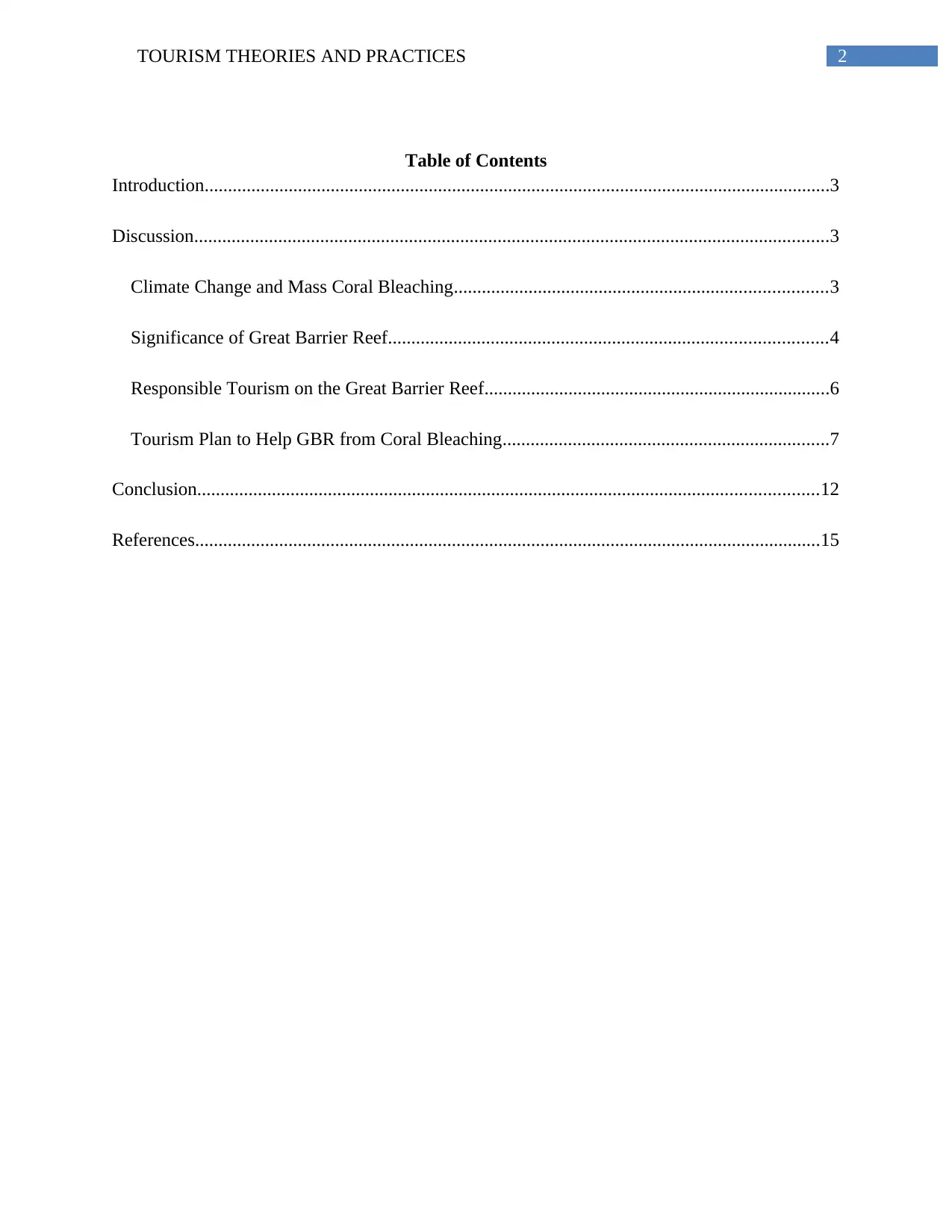
2TOURISM THEORIES AND PRACTICES
Table of Contents
Introduction......................................................................................................................................3
Discussion........................................................................................................................................3
Climate Change and Mass Coral Bleaching................................................................................3
Significance of Great Barrier Reef..............................................................................................4
Responsible Tourism on the Great Barrier Reef..........................................................................6
Tourism Plan to Help GBR from Coral Bleaching......................................................................7
Conclusion.....................................................................................................................................12
References......................................................................................................................................15
Table of Contents
Introduction......................................................................................................................................3
Discussion........................................................................................................................................3
Climate Change and Mass Coral Bleaching................................................................................3
Significance of Great Barrier Reef..............................................................................................4
Responsible Tourism on the Great Barrier Reef..........................................................................6
Tourism Plan to Help GBR from Coral Bleaching......................................................................7
Conclusion.....................................................................................................................................12
References......................................................................................................................................15
⊘ This is a preview!⊘
Do you want full access?
Subscribe today to unlock all pages.

Trusted by 1+ million students worldwide
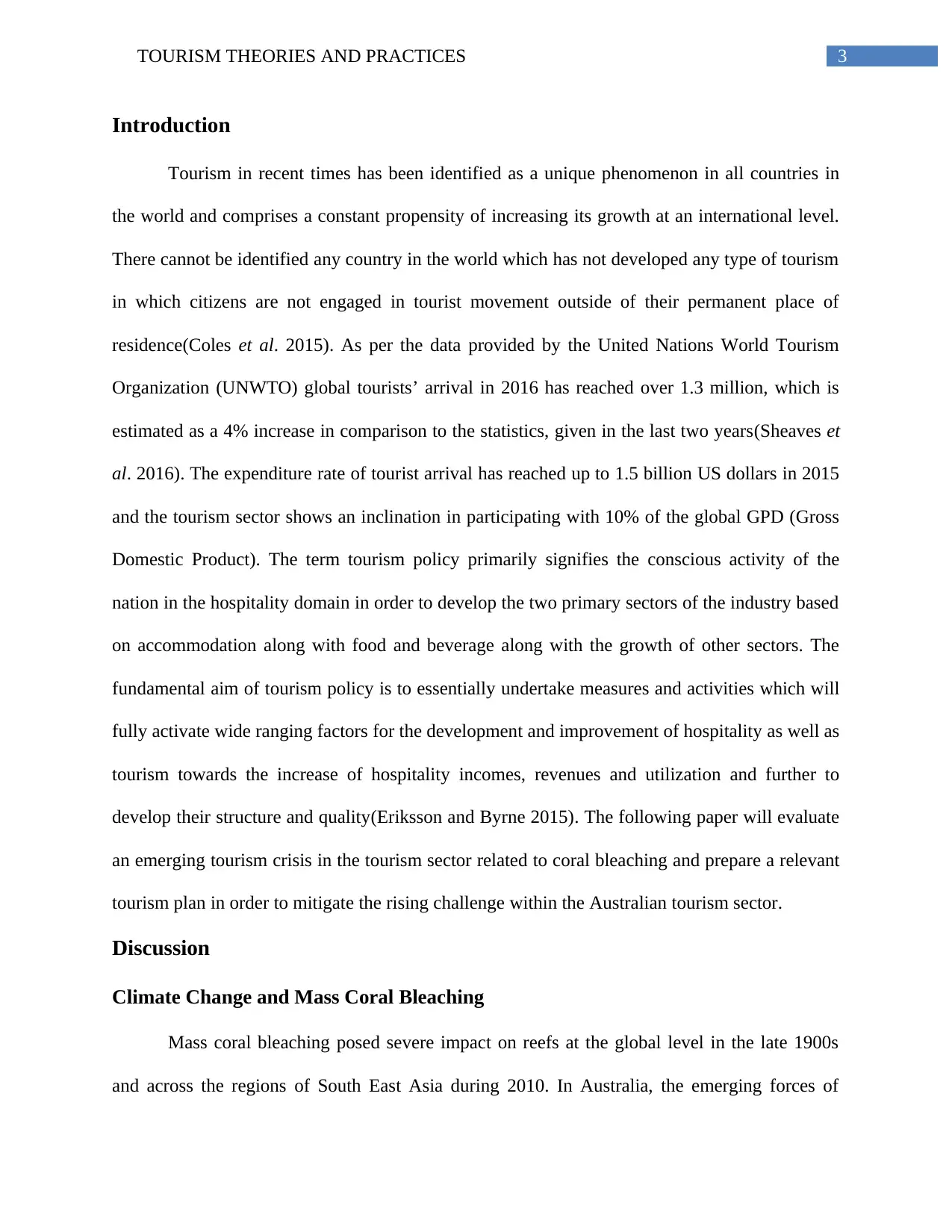
3TOURISM THEORIES AND PRACTICES
Introduction
Tourism in recent times has been identified as a unique phenomenon in all countries in
the world and comprises a constant propensity of increasing its growth at an international level.
There cannot be identified any country in the world which has not developed any type of tourism
in which citizens are not engaged in tourist movement outside of their permanent place of
residence(Coles et al. 2015). As per the data provided by the United Nations World Tourism
Organization (UNWTO) global tourists’ arrival in 2016 has reached over 1.3 million, which is
estimated as a 4% increase in comparison to the statistics, given in the last two years(Sheaves et
al. 2016). The expenditure rate of tourist arrival has reached up to 1.5 billion US dollars in 2015
and the tourism sector shows an inclination in participating with 10% of the global GPD (Gross
Domestic Product). The term tourism policy primarily signifies the conscious activity of the
nation in the hospitality domain in order to develop the two primary sectors of the industry based
on accommodation along with food and beverage along with the growth of other sectors. The
fundamental aim of tourism policy is to essentially undertake measures and activities which will
fully activate wide ranging factors for the development and improvement of hospitality as well as
tourism towards the increase of hospitality incomes, revenues and utilization and further to
develop their structure and quality(Eriksson and Byrne 2015). The following paper will evaluate
an emerging tourism crisis in the tourism sector related to coral bleaching and prepare a relevant
tourism plan in order to mitigate the rising challenge within the Australian tourism sector.
Discussion
Climate Change and Mass Coral Bleaching
Mass coral bleaching posed severe impact on reefs at the global level in the late 1900s
and across the regions of South East Asia during 2010. In Australia, the emerging forces of
Introduction
Tourism in recent times has been identified as a unique phenomenon in all countries in
the world and comprises a constant propensity of increasing its growth at an international level.
There cannot be identified any country in the world which has not developed any type of tourism
in which citizens are not engaged in tourist movement outside of their permanent place of
residence(Coles et al. 2015). As per the data provided by the United Nations World Tourism
Organization (UNWTO) global tourists’ arrival in 2016 has reached over 1.3 million, which is
estimated as a 4% increase in comparison to the statistics, given in the last two years(Sheaves et
al. 2016). The expenditure rate of tourist arrival has reached up to 1.5 billion US dollars in 2015
and the tourism sector shows an inclination in participating with 10% of the global GPD (Gross
Domestic Product). The term tourism policy primarily signifies the conscious activity of the
nation in the hospitality domain in order to develop the two primary sectors of the industry based
on accommodation along with food and beverage along with the growth of other sectors. The
fundamental aim of tourism policy is to essentially undertake measures and activities which will
fully activate wide ranging factors for the development and improvement of hospitality as well as
tourism towards the increase of hospitality incomes, revenues and utilization and further to
develop their structure and quality(Eriksson and Byrne 2015). The following paper will evaluate
an emerging tourism crisis in the tourism sector related to coral bleaching and prepare a relevant
tourism plan in order to mitigate the rising challenge within the Australian tourism sector.
Discussion
Climate Change and Mass Coral Bleaching
Mass coral bleaching posed severe impact on reefs at the global level in the late 1900s
and across the regions of South East Asia during 2010. In Australia, the emerging forces of
Paraphrase This Document
Need a fresh take? Get an instant paraphrase of this document with our AI Paraphraser
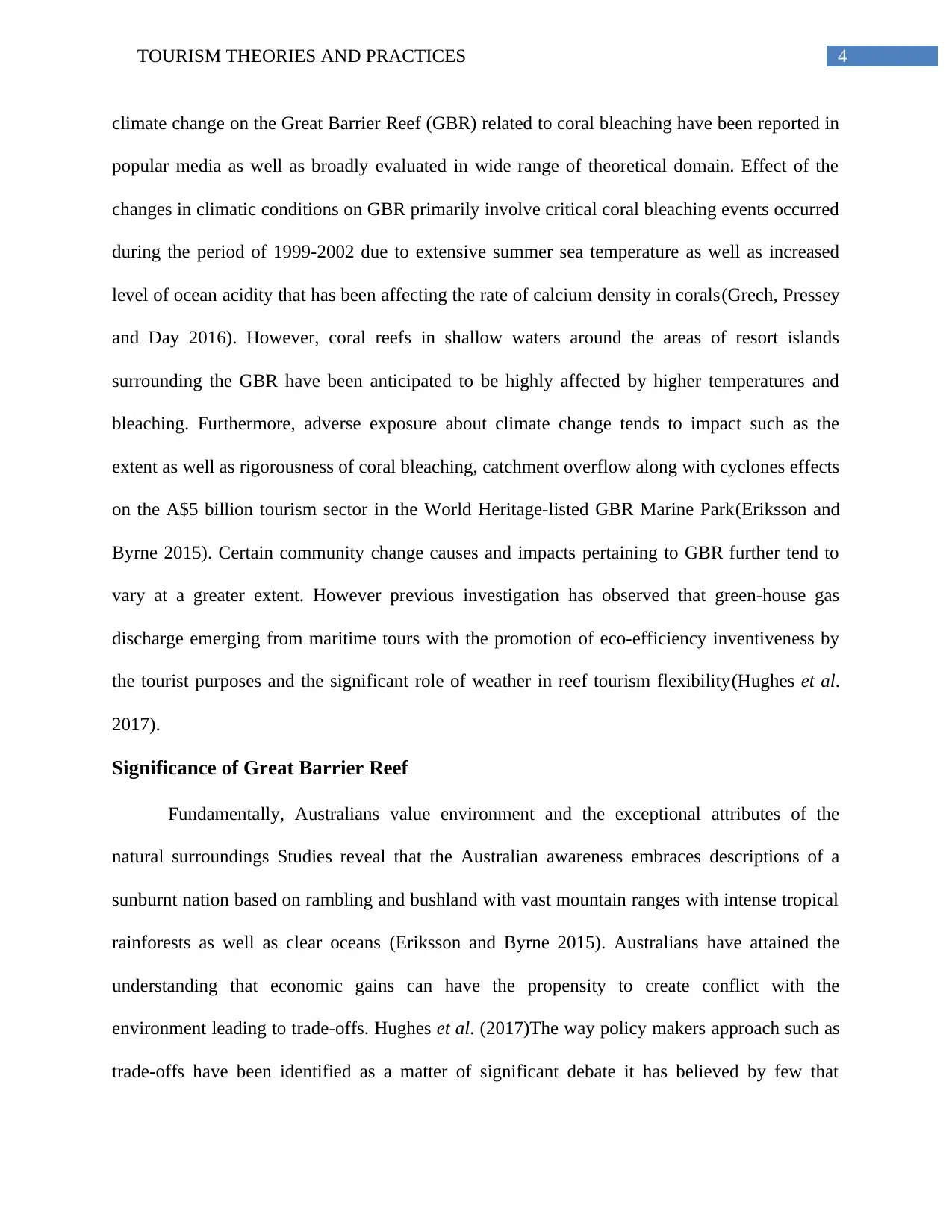
4TOURISM THEORIES AND PRACTICES
climate change on the Great Barrier Reef (GBR) related to coral bleaching have been reported in
popular media as well as broadly evaluated in wide range of theoretical domain. Effect of the
changes in climatic conditions on GBR primarily involve critical coral bleaching events occurred
during the period of 1999-2002 due to extensive summer sea temperature as well as increased
level of ocean acidity that has been affecting the rate of calcium density in corals(Grech, Pressey
and Day 2016). However, coral reefs in shallow waters around the areas of resort islands
surrounding the GBR have been anticipated to be highly affected by higher temperatures and
bleaching. Furthermore, adverse exposure about climate change tends to impact such as the
extent as well as rigorousness of coral bleaching, catchment overflow along with cyclones effects
on the A$5 billion tourism sector in the World Heritage-listed GBR Marine Park(Eriksson and
Byrne 2015). Certain community change causes and impacts pertaining to GBR further tend to
vary at a greater extent. However previous investigation has observed that green-house gas
discharge emerging from maritime tours with the promotion of eco-efficiency inventiveness by
the tourist purposes and the significant role of weather in reef tourism flexibility(Hughes et al.
2017).
Significance of Great Barrier Reef
Fundamentally, Australians value environment and the exceptional attributes of the
natural surroundings Studies reveal that the Australian awareness embraces descriptions of a
sunburnt nation based on rambling and bushland with vast mountain ranges with intense tropical
rainforests as well as clear oceans (Eriksson and Byrne 2015). Australians have attained the
understanding that economic gains can have the propensity to create conflict with the
environment leading to trade-offs. Hughes et al. (2017)The way policy makers approach such as
trade-offs have been identified as a matter of significant debate it has believed by few that
climate change on the Great Barrier Reef (GBR) related to coral bleaching have been reported in
popular media as well as broadly evaluated in wide range of theoretical domain. Effect of the
changes in climatic conditions on GBR primarily involve critical coral bleaching events occurred
during the period of 1999-2002 due to extensive summer sea temperature as well as increased
level of ocean acidity that has been affecting the rate of calcium density in corals(Grech, Pressey
and Day 2016). However, coral reefs in shallow waters around the areas of resort islands
surrounding the GBR have been anticipated to be highly affected by higher temperatures and
bleaching. Furthermore, adverse exposure about climate change tends to impact such as the
extent as well as rigorousness of coral bleaching, catchment overflow along with cyclones effects
on the A$5 billion tourism sector in the World Heritage-listed GBR Marine Park(Eriksson and
Byrne 2015). Certain community change causes and impacts pertaining to GBR further tend to
vary at a greater extent. However previous investigation has observed that green-house gas
discharge emerging from maritime tours with the promotion of eco-efficiency inventiveness by
the tourist purposes and the significant role of weather in reef tourism flexibility(Hughes et al.
2017).
Significance of Great Barrier Reef
Fundamentally, Australians value environment and the exceptional attributes of the
natural surroundings Studies reveal that the Australian awareness embraces descriptions of a
sunburnt nation based on rambling and bushland with vast mountain ranges with intense tropical
rainforests as well as clear oceans (Eriksson and Byrne 2015). Australians have attained the
understanding that economic gains can have the propensity to create conflict with the
environment leading to trade-offs. Hughes et al. (2017)The way policy makers approach such as
trade-offs have been identified as a matter of significant debate it has believed by few that
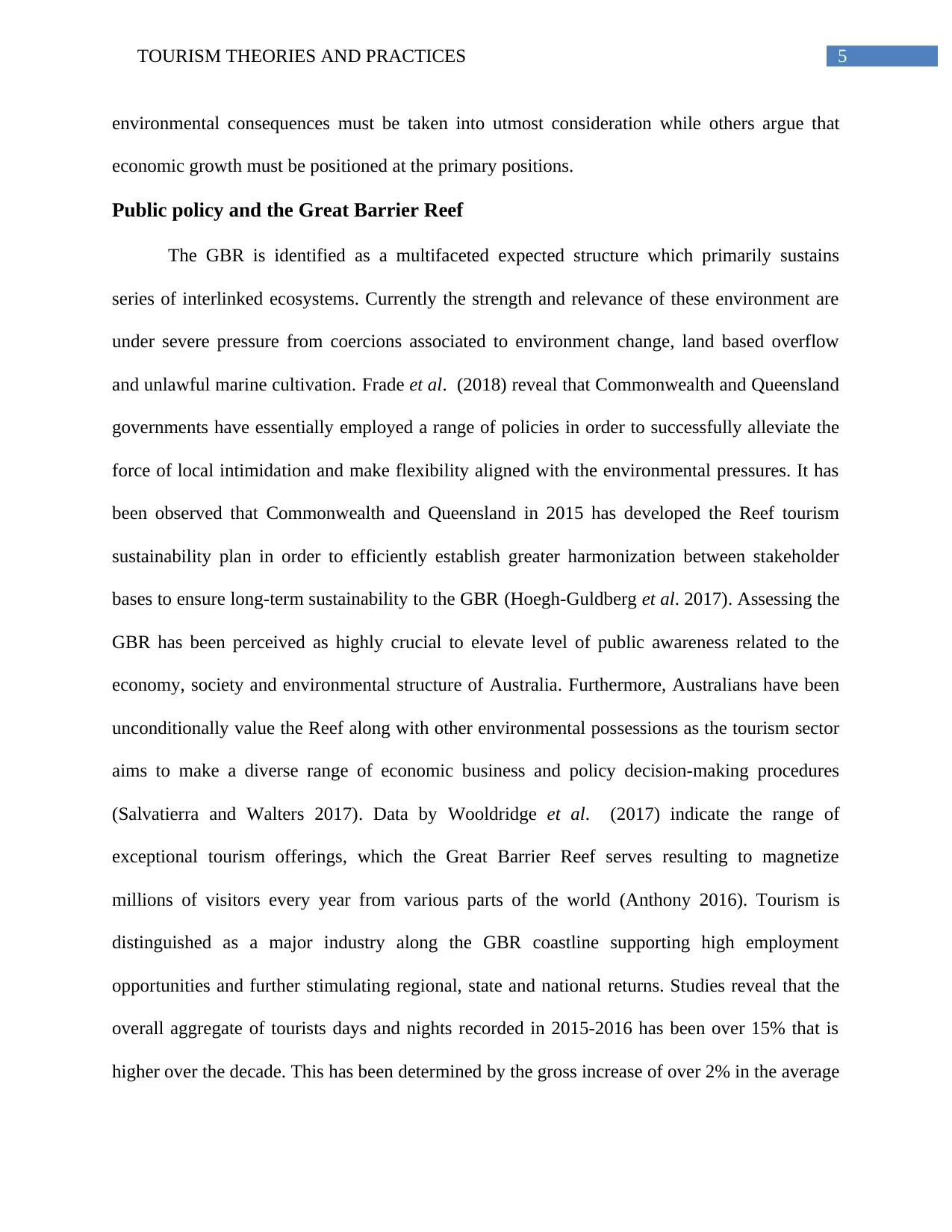
5TOURISM THEORIES AND PRACTICES
environmental consequences must be taken into utmost consideration while others argue that
economic growth must be positioned at the primary positions.
Public policy and the Great Barrier Reef
The GBR is identified as a multifaceted expected structure which primarily sustains
series of interlinked ecosystems. Currently the strength and relevance of these environment are
under severe pressure from coercions associated to environment change, land based overflow
and unlawful marine cultivation. Frade et al. (2018) reveal that Commonwealth and Queensland
governments have essentially employed a range of policies in order to successfully alleviate the
force of local intimidation and make flexibility aligned with the environmental pressures. It has
been observed that Commonwealth and Queensland in 2015 has developed the Reef tourism
sustainability plan in order to efficiently establish greater harmonization between stakeholder
bases to ensure long-term sustainability to the GBR (Hoegh-Guldberg et al. 2017). Assessing the
GBR has been perceived as highly crucial to elevate level of public awareness related to the
economy, society and environmental structure of Australia. Furthermore, Australians have been
unconditionally value the Reef along with other environmental possessions as the tourism sector
aims to make a diverse range of economic business and policy decision-making procedures
(Salvatierra and Walters 2017). Data by Wooldridge et al. (2017) indicate the range of
exceptional tourism offerings, which the Great Barrier Reef serves resulting to magnetize
millions of visitors every year from various parts of the world (Anthony 2016). Tourism is
distinguished as a major industry along the GBR coastline supporting high employment
opportunities and further stimulating regional, state and national returns. Studies reveal that the
overall aggregate of tourists days and nights recorded in 2015-2016 has been over 15% that is
higher over the decade. This has been determined by the gross increase of over 2% in the average
environmental consequences must be taken into utmost consideration while others argue that
economic growth must be positioned at the primary positions.
Public policy and the Great Barrier Reef
The GBR is identified as a multifaceted expected structure which primarily sustains
series of interlinked ecosystems. Currently the strength and relevance of these environment are
under severe pressure from coercions associated to environment change, land based overflow
and unlawful marine cultivation. Frade et al. (2018) reveal that Commonwealth and Queensland
governments have essentially employed a range of policies in order to successfully alleviate the
force of local intimidation and make flexibility aligned with the environmental pressures. It has
been observed that Commonwealth and Queensland in 2015 has developed the Reef tourism
sustainability plan in order to efficiently establish greater harmonization between stakeholder
bases to ensure long-term sustainability to the GBR (Hoegh-Guldberg et al. 2017). Assessing the
GBR has been perceived as highly crucial to elevate level of public awareness related to the
economy, society and environmental structure of Australia. Furthermore, Australians have been
unconditionally value the Reef along with other environmental possessions as the tourism sector
aims to make a diverse range of economic business and policy decision-making procedures
(Salvatierra and Walters 2017). Data by Wooldridge et al. (2017) indicate the range of
exceptional tourism offerings, which the Great Barrier Reef serves resulting to magnetize
millions of visitors every year from various parts of the world (Anthony 2016). Tourism is
distinguished as a major industry along the GBR coastline supporting high employment
opportunities and further stimulating regional, state and national returns. Studies reveal that the
overall aggregate of tourists days and nights recorded in 2015-2016 has been over 15% that is
higher over the decade. This has been determined by the gross increase of over 2% in the average
⊘ This is a preview!⊘
Do you want full access?
Subscribe today to unlock all pages.

Trusted by 1+ million students worldwide
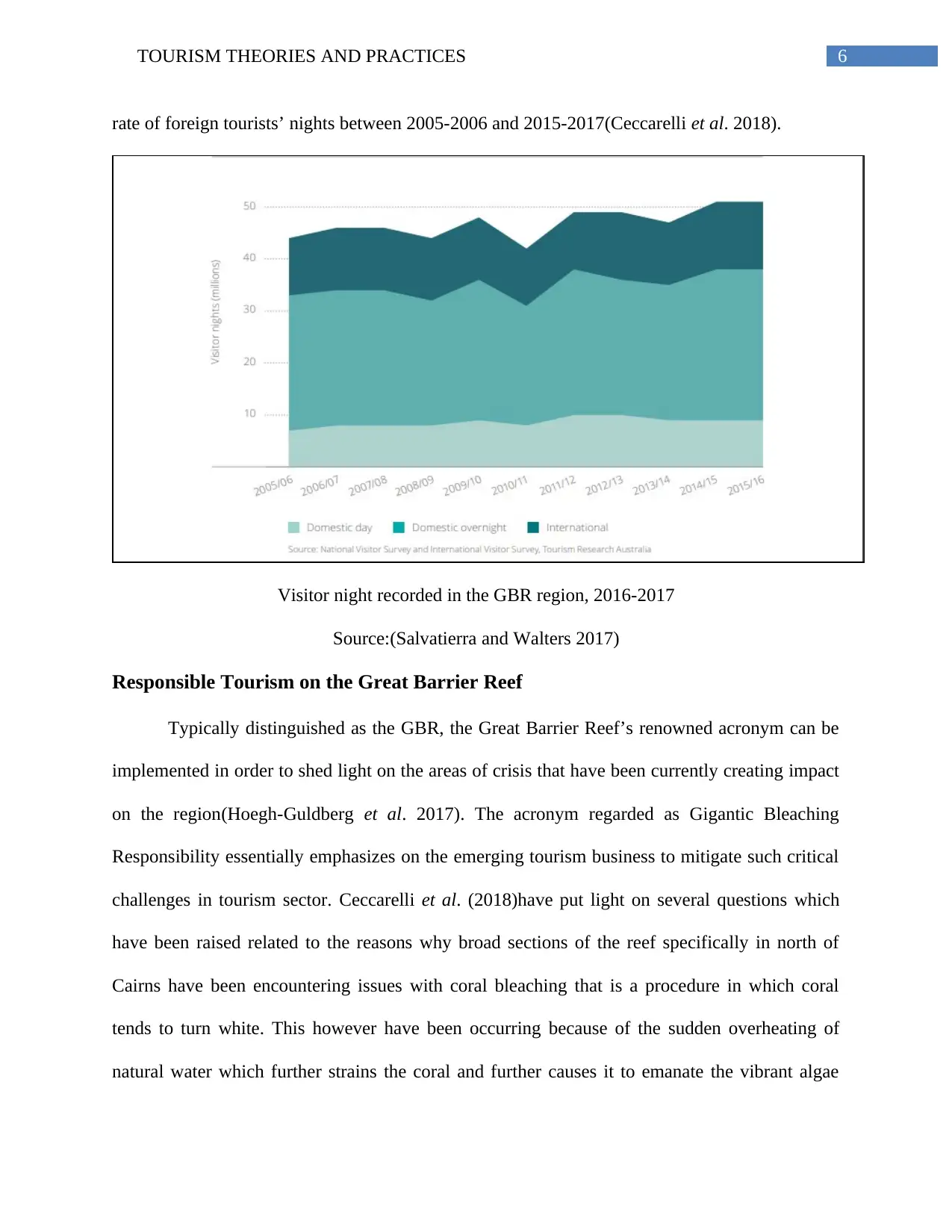
6TOURISM THEORIES AND PRACTICES
rate of foreign tourists’ nights between 2005-2006 and 2015-2017(Ceccarelli et al. 2018).
Visitor night recorded in the GBR region, 2016-2017
Source:(Salvatierra and Walters 2017)
Responsible Tourism on the Great Barrier Reef
Typically distinguished as the GBR, the Great Barrier Reef’s renowned acronym can be
implemented in order to shed light on the areas of crisis that have been currently creating impact
on the region(Hoegh-Guldberg et al. 2017). The acronym regarded as Gigantic Bleaching
Responsibility essentially emphasizes on the emerging tourism business to mitigate such critical
challenges in tourism sector. Ceccarelli et al. (2018)have put light on several questions which
have been raised related to the reasons why broad sections of the reef specifically in north of
Cairns have been encountering issues with coral bleaching that is a procedure in which coral
tends to turn white. This however have been occurring because of the sudden overheating of
natural water which further strains the coral and further causes it to emanate the vibrant algae
rate of foreign tourists’ nights between 2005-2006 and 2015-2017(Ceccarelli et al. 2018).
Visitor night recorded in the GBR region, 2016-2017
Source:(Salvatierra and Walters 2017)
Responsible Tourism on the Great Barrier Reef
Typically distinguished as the GBR, the Great Barrier Reef’s renowned acronym can be
implemented in order to shed light on the areas of crisis that have been currently creating impact
on the region(Hoegh-Guldberg et al. 2017). The acronym regarded as Gigantic Bleaching
Responsibility essentially emphasizes on the emerging tourism business to mitigate such critical
challenges in tourism sector. Ceccarelli et al. (2018)have put light on several questions which
have been raised related to the reasons why broad sections of the reef specifically in north of
Cairns have been encountering issues with coral bleaching that is a procedure in which coral
tends to turn white. This however have been occurring because of the sudden overheating of
natural water which further strains the coral and further causes it to emanate the vibrant algae
Paraphrase This Document
Need a fresh take? Get an instant paraphrase of this document with our AI Paraphraser
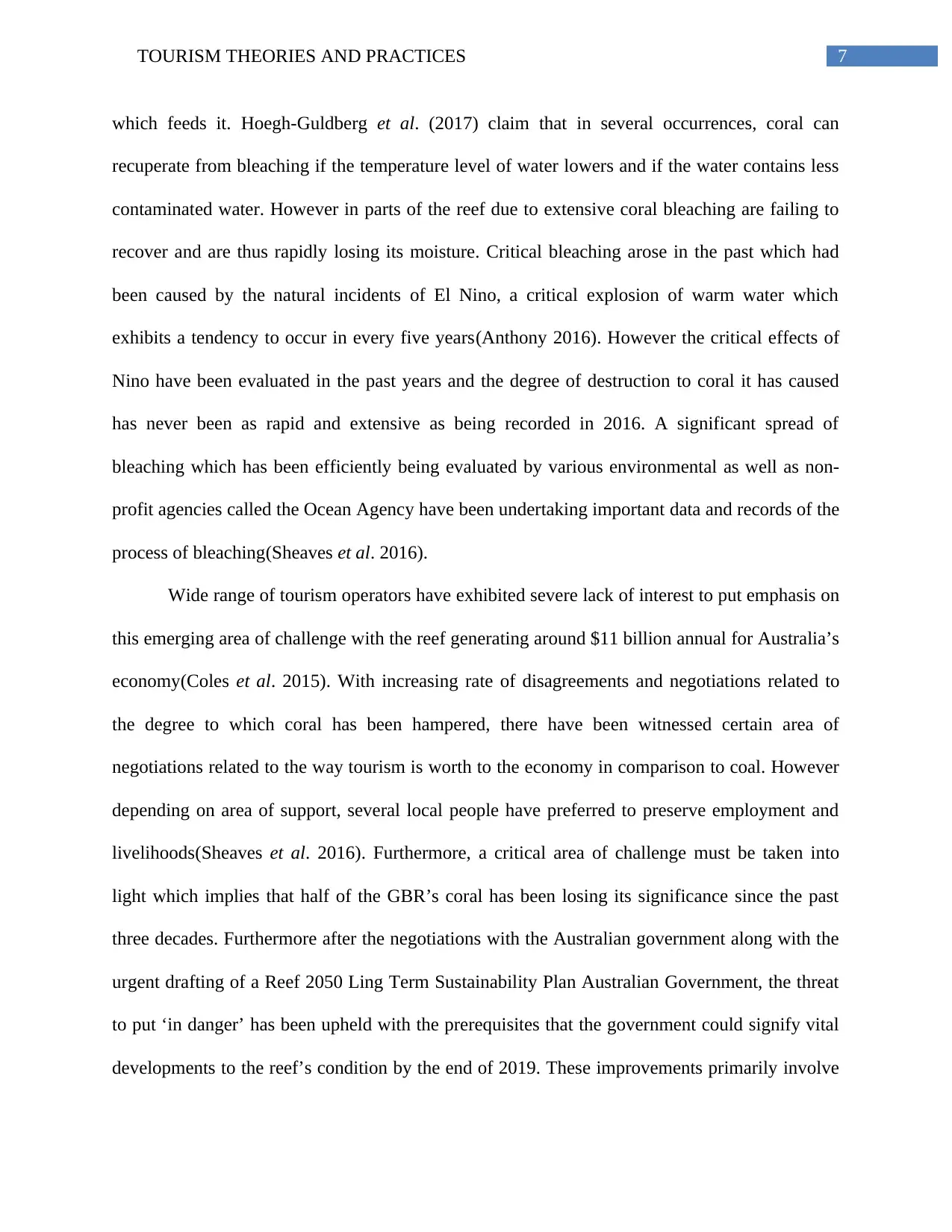
7TOURISM THEORIES AND PRACTICES
which feeds it. Hoegh-Guldberg et al. (2017) claim that in several occurrences, coral can
recuperate from bleaching if the temperature level of water lowers and if the water contains less
contaminated water. However in parts of the reef due to extensive coral bleaching are failing to
recover and are thus rapidly losing its moisture. Critical bleaching arose in the past which had
been caused by the natural incidents of El Nino, a critical explosion of warm water which
exhibits a tendency to occur in every five years(Anthony 2016). However the critical effects of
Nino have been evaluated in the past years and the degree of destruction to coral it has caused
has never been as rapid and extensive as being recorded in 2016. A significant spread of
bleaching which has been efficiently being evaluated by various environmental as well as non-
profit agencies called the Ocean Agency have been undertaking important data and records of the
process of bleaching(Sheaves et al. 2016).
Wide range of tourism operators have exhibited severe lack of interest to put emphasis on
this emerging area of challenge with the reef generating around $11 billion annual for Australia’s
economy(Coles et al. 2015). With increasing rate of disagreements and negotiations related to
the degree to which coral has been hampered, there have been witnessed certain area of
negotiations related to the way tourism is worth to the economy in comparison to coal. However
depending on area of support, several local people have preferred to preserve employment and
livelihoods(Sheaves et al. 2016). Furthermore, a critical area of challenge must be taken into
light which implies that half of the GBR’s coral has been losing its significance since the past
three decades. Furthermore after the negotiations with the Australian government along with the
urgent drafting of a Reef 2050 Ling Term Sustainability Plan Australian Government, the threat
to put ‘in danger’ has been upheld with the prerequisites that the government could signify vital
developments to the reef’s condition by the end of 2019. These improvements primarily involve
which feeds it. Hoegh-Guldberg et al. (2017) claim that in several occurrences, coral can
recuperate from bleaching if the temperature level of water lowers and if the water contains less
contaminated water. However in parts of the reef due to extensive coral bleaching are failing to
recover and are thus rapidly losing its moisture. Critical bleaching arose in the past which had
been caused by the natural incidents of El Nino, a critical explosion of warm water which
exhibits a tendency to occur in every five years(Anthony 2016). However the critical effects of
Nino have been evaluated in the past years and the degree of destruction to coral it has caused
has never been as rapid and extensive as being recorded in 2016. A significant spread of
bleaching which has been efficiently being evaluated by various environmental as well as non-
profit agencies called the Ocean Agency have been undertaking important data and records of the
process of bleaching(Sheaves et al. 2016).
Wide range of tourism operators have exhibited severe lack of interest to put emphasis on
this emerging area of challenge with the reef generating around $11 billion annual for Australia’s
economy(Coles et al. 2015). With increasing rate of disagreements and negotiations related to
the degree to which coral has been hampered, there have been witnessed certain area of
negotiations related to the way tourism is worth to the economy in comparison to coal. However
depending on area of support, several local people have preferred to preserve employment and
livelihoods(Sheaves et al. 2016). Furthermore, a critical area of challenge must be taken into
light which implies that half of the GBR’s coral has been losing its significance since the past
three decades. Furthermore after the negotiations with the Australian government along with the
urgent drafting of a Reef 2050 Ling Term Sustainability Plan Australian Government, the threat
to put ‘in danger’ has been upheld with the prerequisites that the government could signify vital
developments to the reef’s condition by the end of 2019. These improvements primarily involve
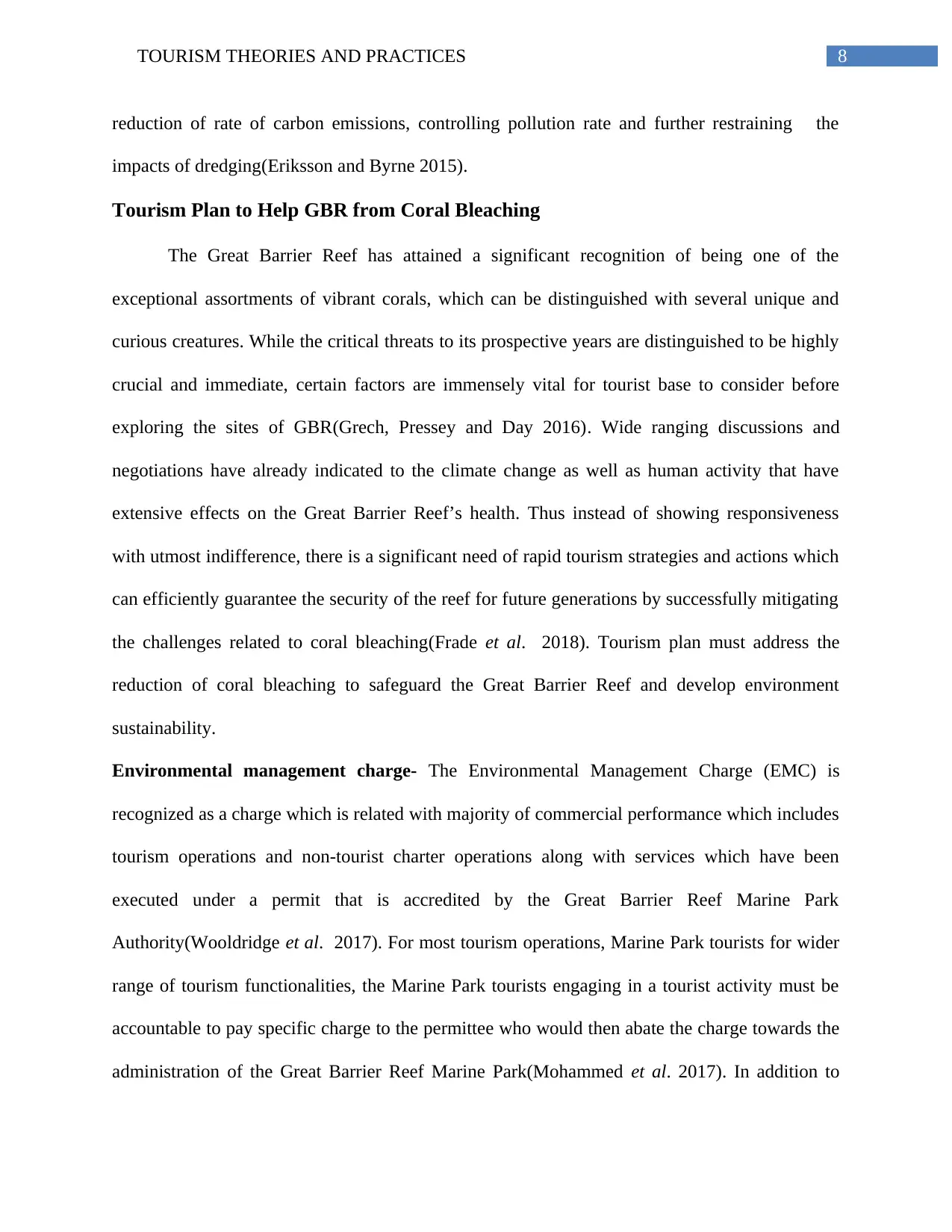
8TOURISM THEORIES AND PRACTICES
reduction of rate of carbon emissions, controlling pollution rate and further restraining the
impacts of dredging(Eriksson and Byrne 2015).
Tourism Plan to Help GBR from Coral Bleaching
The Great Barrier Reef has attained a significant recognition of being one of the
exceptional assortments of vibrant corals, which can be distinguished with several unique and
curious creatures. While the critical threats to its prospective years are distinguished to be highly
crucial and immediate, certain factors are immensely vital for tourist base to consider before
exploring the sites of GBR(Grech, Pressey and Day 2016). Wide ranging discussions and
negotiations have already indicated to the climate change as well as human activity that have
extensive effects on the Great Barrier Reef’s health. Thus instead of showing responsiveness
with utmost indifference, there is a significant need of rapid tourism strategies and actions which
can efficiently guarantee the security of the reef for future generations by successfully mitigating
the challenges related to coral bleaching(Frade et al. 2018). Tourism plan must address the
reduction of coral bleaching to safeguard the Great Barrier Reef and develop environment
sustainability.
Environmental management charge- The Environmental Management Charge (EMC) is
recognized as a charge which is related with majority of commercial performance which includes
tourism operations and non-tourist charter operations along with services which have been
executed under a permit that is accredited by the Great Barrier Reef Marine Park
Authority(Wooldridge et al. 2017). For most tourism operations, Marine Park tourists for wider
range of tourism functionalities, the Marine Park tourists engaging in a tourist activity must be
accountable to pay specific charge to the permittee who would then abate the charge towards the
administration of the Great Barrier Reef Marine Park(Mohammed et al. 2017). In addition to
reduction of rate of carbon emissions, controlling pollution rate and further restraining the
impacts of dredging(Eriksson and Byrne 2015).
Tourism Plan to Help GBR from Coral Bleaching
The Great Barrier Reef has attained a significant recognition of being one of the
exceptional assortments of vibrant corals, which can be distinguished with several unique and
curious creatures. While the critical threats to its prospective years are distinguished to be highly
crucial and immediate, certain factors are immensely vital for tourist base to consider before
exploring the sites of GBR(Grech, Pressey and Day 2016). Wide ranging discussions and
negotiations have already indicated to the climate change as well as human activity that have
extensive effects on the Great Barrier Reef’s health. Thus instead of showing responsiveness
with utmost indifference, there is a significant need of rapid tourism strategies and actions which
can efficiently guarantee the security of the reef for future generations by successfully mitigating
the challenges related to coral bleaching(Frade et al. 2018). Tourism plan must address the
reduction of coral bleaching to safeguard the Great Barrier Reef and develop environment
sustainability.
Environmental management charge- The Environmental Management Charge (EMC) is
recognized as a charge which is related with majority of commercial performance which includes
tourism operations and non-tourist charter operations along with services which have been
executed under a permit that is accredited by the Great Barrier Reef Marine Park
Authority(Wooldridge et al. 2017). For most tourism operations, Marine Park tourists for wider
range of tourism functionalities, the Marine Park tourists engaging in a tourist activity must be
accountable to pay specific charge to the permittee who would then abate the charge towards the
administration of the Great Barrier Reef Marine Park(Mohammed et al. 2017). In addition to
⊘ This is a preview!⊘
Do you want full access?
Subscribe today to unlock all pages.

Trusted by 1+ million students worldwide
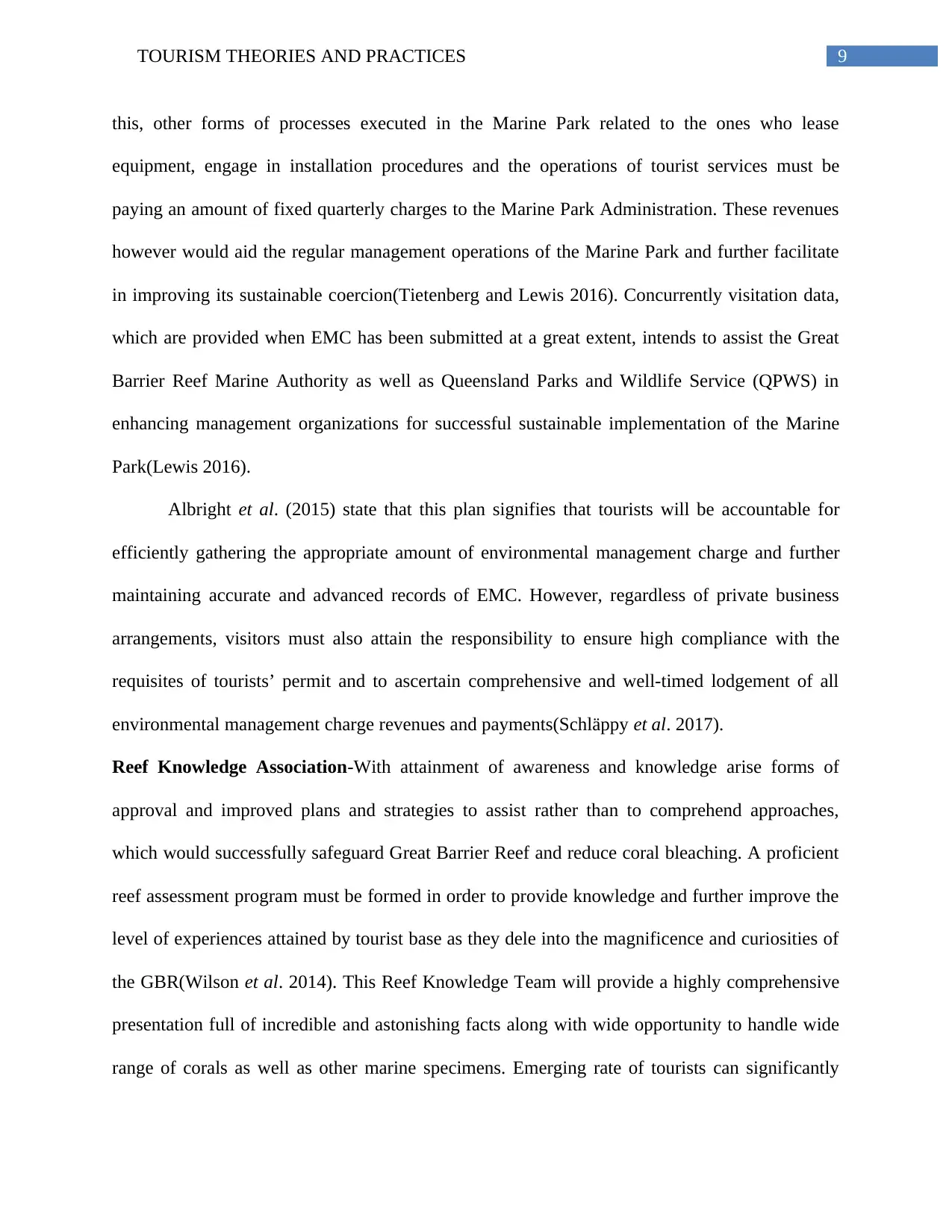
9TOURISM THEORIES AND PRACTICES
this, other forms of processes executed in the Marine Park related to the ones who lease
equipment, engage in installation procedures and the operations of tourist services must be
paying an amount of fixed quarterly charges to the Marine Park Administration. These revenues
however would aid the regular management operations of the Marine Park and further facilitate
in improving its sustainable coercion(Tietenberg and Lewis 2016). Concurrently visitation data,
which are provided when EMC has been submitted at a great extent, intends to assist the Great
Barrier Reef Marine Authority as well as Queensland Parks and Wildlife Service (QPWS) in
enhancing management organizations for successful sustainable implementation of the Marine
Park(Lewis 2016).
Albright et al. (2015) state that this plan signifies that tourists will be accountable for
efficiently gathering the appropriate amount of environmental management charge and further
maintaining accurate and advanced records of EMC. However, regardless of private business
arrangements, visitors must also attain the responsibility to ensure high compliance with the
requisites of tourists’ permit and to ascertain comprehensive and well-timed lodgement of all
environmental management charge revenues and payments(Schläppy et al. 2017).
Reef Knowledge Association-With attainment of awareness and knowledge arise forms of
approval and improved plans and strategies to assist rather than to comprehend approaches,
which would successfully safeguard Great Barrier Reef and reduce coral bleaching. A proficient
reef assessment program must be formed in order to provide knowledge and further improve the
level of experiences attained by tourist base as they dele into the magnificence and curiosities of
the GBR(Wilson et al. 2014). This Reef Knowledge Team will provide a highly comprehensive
presentation full of incredible and astonishing facts along with wide opportunity to handle wide
range of corals as well as other marine specimens. Emerging rate of tourists can significantly
this, other forms of processes executed in the Marine Park related to the ones who lease
equipment, engage in installation procedures and the operations of tourist services must be
paying an amount of fixed quarterly charges to the Marine Park Administration. These revenues
however would aid the regular management operations of the Marine Park and further facilitate
in improving its sustainable coercion(Tietenberg and Lewis 2016). Concurrently visitation data,
which are provided when EMC has been submitted at a great extent, intends to assist the Great
Barrier Reef Marine Authority as well as Queensland Parks and Wildlife Service (QPWS) in
enhancing management organizations for successful sustainable implementation of the Marine
Park(Lewis 2016).
Albright et al. (2015) state that this plan signifies that tourists will be accountable for
efficiently gathering the appropriate amount of environmental management charge and further
maintaining accurate and advanced records of EMC. However, regardless of private business
arrangements, visitors must also attain the responsibility to ensure high compliance with the
requisites of tourists’ permit and to ascertain comprehensive and well-timed lodgement of all
environmental management charge revenues and payments(Schläppy et al. 2017).
Reef Knowledge Association-With attainment of awareness and knowledge arise forms of
approval and improved plans and strategies to assist rather than to comprehend approaches,
which would successfully safeguard Great Barrier Reef and reduce coral bleaching. A proficient
reef assessment program must be formed in order to provide knowledge and further improve the
level of experiences attained by tourist base as they dele into the magnificence and curiosities of
the GBR(Wilson et al. 2014). This Reef Knowledge Team will provide a highly comprehensive
presentation full of incredible and astonishing facts along with wide opportunity to handle wide
range of corals as well as other marine specimens. Emerging rate of tourists can significantly
Paraphrase This Document
Need a fresh take? Get an instant paraphrase of this document with our AI Paraphraser
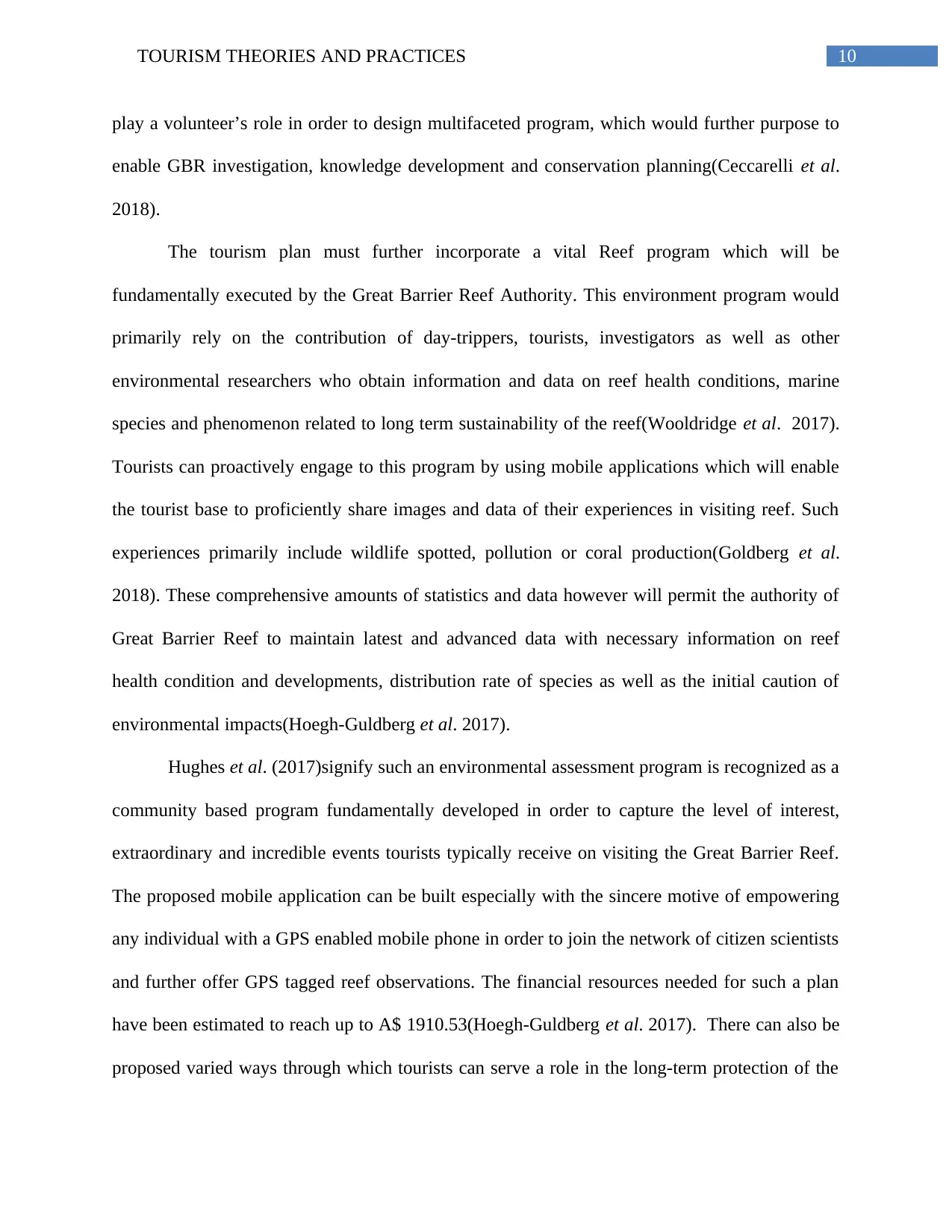
10TOURISM THEORIES AND PRACTICES
play a volunteer’s role in order to design multifaceted program, which would further purpose to
enable GBR investigation, knowledge development and conservation planning(Ceccarelli et al.
2018).
The tourism plan must further incorporate a vital Reef program which will be
fundamentally executed by the Great Barrier Reef Authority. This environment program would
primarily rely on the contribution of day-trippers, tourists, investigators as well as other
environmental researchers who obtain information and data on reef health conditions, marine
species and phenomenon related to long term sustainability of the reef(Wooldridge et al. 2017).
Tourists can proactively engage to this program by using mobile applications which will enable
the tourist base to proficiently share images and data of their experiences in visiting reef. Such
experiences primarily include wildlife spotted, pollution or coral production(Goldberg et al.
2018). These comprehensive amounts of statistics and data however will permit the authority of
Great Barrier Reef to maintain latest and advanced data with necessary information on reef
health condition and developments, distribution rate of species as well as the initial caution of
environmental impacts(Hoegh-Guldberg et al. 2017).
Hughes et al. (2017)signify such an environmental assessment program is recognized as a
community based program fundamentally developed in order to capture the level of interest,
extraordinary and incredible events tourists typically receive on visiting the Great Barrier Reef.
The proposed mobile application can be built especially with the sincere motive of empowering
any individual with a GPS enabled mobile phone in order to join the network of citizen scientists
and further offer GPS tagged reef observations. The financial resources needed for such a plan
have been estimated to reach up to A$ 1910.53(Hoegh-Guldberg et al. 2017). There can also be
proposed varied ways through which tourists can serve a role in the long-term protection of the
play a volunteer’s role in order to design multifaceted program, which would further purpose to
enable GBR investigation, knowledge development and conservation planning(Ceccarelli et al.
2018).
The tourism plan must further incorporate a vital Reef program which will be
fundamentally executed by the Great Barrier Reef Authority. This environment program would
primarily rely on the contribution of day-trippers, tourists, investigators as well as other
environmental researchers who obtain information and data on reef health conditions, marine
species and phenomenon related to long term sustainability of the reef(Wooldridge et al. 2017).
Tourists can proactively engage to this program by using mobile applications which will enable
the tourist base to proficiently share images and data of their experiences in visiting reef. Such
experiences primarily include wildlife spotted, pollution or coral production(Goldberg et al.
2018). These comprehensive amounts of statistics and data however will permit the authority of
Great Barrier Reef to maintain latest and advanced data with necessary information on reef
health condition and developments, distribution rate of species as well as the initial caution of
environmental impacts(Hoegh-Guldberg et al. 2017).
Hughes et al. (2017)signify such an environmental assessment program is recognized as a
community based program fundamentally developed in order to capture the level of interest,
extraordinary and incredible events tourists typically receive on visiting the Great Barrier Reef.
The proposed mobile application can be built especially with the sincere motive of empowering
any individual with a GPS enabled mobile phone in order to join the network of citizen scientists
and further offer GPS tagged reef observations. The financial resources needed for such a plan
have been estimated to reach up to A$ 1910.53(Hoegh-Guldberg et al. 2017). There can also be
proposed varied ways through which tourists can serve a role in the long-term protection of the
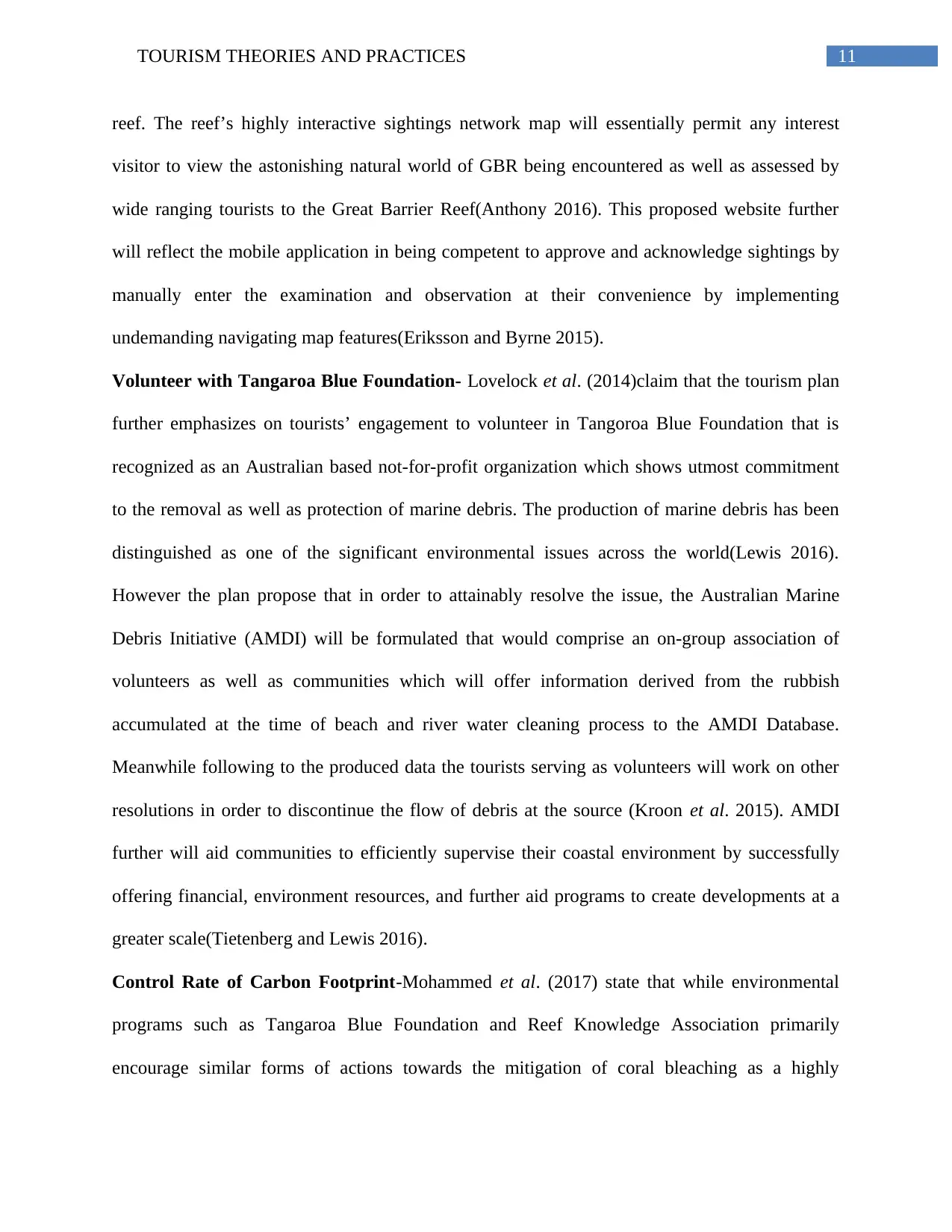
11TOURISM THEORIES AND PRACTICES
reef. The reef’s highly interactive sightings network map will essentially permit any interest
visitor to view the astonishing natural world of GBR being encountered as well as assessed by
wide ranging tourists to the Great Barrier Reef(Anthony 2016). This proposed website further
will reflect the mobile application in being competent to approve and acknowledge sightings by
manually enter the examination and observation at their convenience by implementing
undemanding navigating map features(Eriksson and Byrne 2015).
Volunteer with Tangaroa Blue Foundation- Lovelock et al. (2014)claim that the tourism plan
further emphasizes on tourists’ engagement to volunteer in Tangoroa Blue Foundation that is
recognized as an Australian based not-for-profit organization which shows utmost commitment
to the removal as well as protection of marine debris. The production of marine debris has been
distinguished as one of the significant environmental issues across the world(Lewis 2016).
However the plan propose that in order to attainably resolve the issue, the Australian Marine
Debris Initiative (AMDI) will be formulated that would comprise an on-group association of
volunteers as well as communities which will offer information derived from the rubbish
accumulated at the time of beach and river water cleaning process to the AMDI Database.
Meanwhile following to the produced data the tourists serving as volunteers will work on other
resolutions in order to discontinue the flow of debris at the source (Kroon et al. 2015). AMDI
further will aid communities to efficiently supervise their coastal environment by successfully
offering financial, environment resources, and further aid programs to create developments at a
greater scale(Tietenberg and Lewis 2016).
Control Rate of Carbon Footprint-Mohammed et al. (2017) state that while environmental
programs such as Tangaroa Blue Foundation and Reef Knowledge Association primarily
encourage similar forms of actions towards the mitigation of coral bleaching as a highly
reef. The reef’s highly interactive sightings network map will essentially permit any interest
visitor to view the astonishing natural world of GBR being encountered as well as assessed by
wide ranging tourists to the Great Barrier Reef(Anthony 2016). This proposed website further
will reflect the mobile application in being competent to approve and acknowledge sightings by
manually enter the examination and observation at their convenience by implementing
undemanding navigating map features(Eriksson and Byrne 2015).
Volunteer with Tangaroa Blue Foundation- Lovelock et al. (2014)claim that the tourism plan
further emphasizes on tourists’ engagement to volunteer in Tangoroa Blue Foundation that is
recognized as an Australian based not-for-profit organization which shows utmost commitment
to the removal as well as protection of marine debris. The production of marine debris has been
distinguished as one of the significant environmental issues across the world(Lewis 2016).
However the plan propose that in order to attainably resolve the issue, the Australian Marine
Debris Initiative (AMDI) will be formulated that would comprise an on-group association of
volunteers as well as communities which will offer information derived from the rubbish
accumulated at the time of beach and river water cleaning process to the AMDI Database.
Meanwhile following to the produced data the tourists serving as volunteers will work on other
resolutions in order to discontinue the flow of debris at the source (Kroon et al. 2015). AMDI
further will aid communities to efficiently supervise their coastal environment by successfully
offering financial, environment resources, and further aid programs to create developments at a
greater scale(Tietenberg and Lewis 2016).
Control Rate of Carbon Footprint-Mohammed et al. (2017) state that while environmental
programs such as Tangaroa Blue Foundation and Reef Knowledge Association primarily
encourage similar forms of actions towards the mitigation of coral bleaching as a highly
⊘ This is a preview!⊘
Do you want full access?
Subscribe today to unlock all pages.

Trusted by 1+ million students worldwide
1 out of 18
Related Documents
Your All-in-One AI-Powered Toolkit for Academic Success.
+13062052269
info@desklib.com
Available 24*7 on WhatsApp / Email
![[object Object]](/_next/static/media/star-bottom.7253800d.svg)
Unlock your academic potential
Copyright © 2020–2025 A2Z Services. All Rights Reserved. Developed and managed by ZUCOL.





